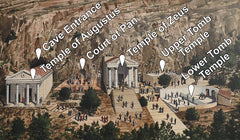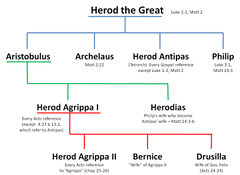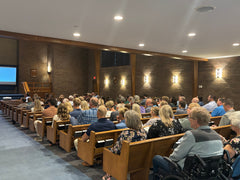Your cart is empty now.

Social Constructionism (9): Ideas have Legs
For within the framework of men’s bodies is generated the most powerful explosive force known in history—the explosive force of ideas. …Ideas change men. Ideas shape nations. So many ideas bid for the allegiance of each human heart as it takes its journey from the womb to the tomb. And when millions of ordinary men and women begin to follow the same star history is molded.
Great Britain’s Peter Howard wrote this shortly after World War II in his book Ideas Have Legs. With European soil still soaking in the blood of innocent Jews, the people of the 1940s experienced in raw form the truth that there are consequences to ideas.
Social constructionism is one of the great ideas which has legs. It produces an abundance of human action. If ideas are an “explosive force,” social constructionism and its network of corresponding theories is a nuclear bomb. I state this because social constructionism isn’t just an isolated theory waiting for someone to take it to its logical end. Social constructionism is wrapped up in social action and it is self-generating. It isn’t content to let human action flow from it organically.
One of the tenets of social constructionism is the idea of praxis. Praxis is an old Greek word that has been baptized in Marxist theory and used with much devotion by many postmodern scholars. Praxis is the idea of doing theory. The idea is that theory (or an idea) is perfected through human activity. Our theory flows out of our practice and our practice informs our theory. So, human action is integral to social constructionism. It is part of the warp and woof.
Postmodern researchers operating within a social constructionist framework will often engage in action research. Vivien Burr writes “the aim [of action research—RM] is not just to study some existing state of affairs but to change them for the better…the values and political agenda motivating the research is therefore explicitly acknowledged.”[1] This form of research, which is flourishing in colleges and universities, is designed to address “problems” with the goal of rectification. What is considered a problem and who gets to make this determination is the real problem. It certainly isn’t the word of God.
Action research has been accompanied by another practice: activism. Activism is direct, vigorous action by people in order to change the status quo. At its root, activism isn’t a new concept. History is replete with groups rising up for a cause. However, modern activism has been exploding. It is being done on all sides of the political and religious spectrum. More recently, we see corporations engaging in it. The idea of activism and active research is central to social constructionism. Both are a call to social action in an effort to socially construct a new reality.
Why? Let’s remember what social constructionism is all about. Knowledge is socially constructed. Recall from the last post, they claim knowledge is constructed through human interaction. The social constructivists aren’t content to simply assert this claim and then stand by and wait for interaction to take place. Social constructivists are compelled to produce interaction through their philosophy of praxis.
Since social constructionism is rooted in Marxism and Humanism[2], the agenda is secular and serves the kingdom of man. Often it is cloaked in the term social justice. At Calvin College, where I attended, this humanistic social justice is cloaked in the Jewish concept of Shalom, which means “peace.” In this context, it is a “vision of human flourishing. Shalom means people living in right relationships with God, themselves, each other, and nature—and in taking delight in such relationships.”[3] Participation in social justice ventures on the basis of shalom is erasing the antithesis between the kingdom of man and the kingdom of God. One hardly knows which kingdom and on whose behalf he is laboring in.
Whether it is responsive action for the sake of a culturally identified social injustice or a foolishly conceived disruption in a heretical conception of God’s kingdom, the human activity to construct a new reality isn’t Christ centered. The agenda isn’t a closer obedience to God’s word. It isn’t the advancement of biblically based institutions. It isn’t the affirmation of the creation ordinances of work/vocation, marriage/family, and rest. Rather, the prince of darkness has his tentacles deep within postmodernism. His kingdom is being advanced through this agenda-driven human action.
In conclusion, social constructionism combines knowledge and social action. The social action is resulting in widespread action research and activism. This activity is not promoting a God centered agenda, but it is fueling the rise of man’s kingdom where the prince of darkness and his evil host stalk behind every shadow and crevice.
This post completes my brief examination of the four basic characteristics of social constructionism: 1.) A critical stance toward taken-for-granted knowledge; 2.) Knowledge is historically and culturally relative; 3.) Knowledge is sustained by social processes; 4.) Social action is integral to knowledge. I intend to conclude this series with a post or two on the educational practices that are rooted in constructivism. This is where the rubber really hits the road and that road comes close to home.
______________
[1] Burr, Vivien. Social constructionism. 2. ed. Routledge, 2004.
[2] Berger, Peter Ludwig, and Thomas Luckmann. The Social Construction of Reality: a Treatise in the Sociology of Knowledge. Anchor Book, 1996.
[3] Wolterstorff, Nicholas, et al. “Introduction.” Educating for Shalom: Essays on Christian Higher Education, W.B. Eerdmans Pub. Co, 2004, p. 13.
_______________
This post was written by Rick Mingerink, a member of the Byron Center Protestant Reformed Church in Michigan. Rick is also a principal at a Christian school in West Michigan. If you have a question or comment for Rick, please do so in the comment section.
The content of the article above is the sole responsibility of the article author. This article does not necessarily reflect the opinions and beliefs of the Reformed Free Publishing staff or Association, and the article author does not speak for the RFPA.

Donate
Your contributions make it possible for us to reach Christians in more markets and more lands around the world than ever before.
Select Frequency
Enter Amount










